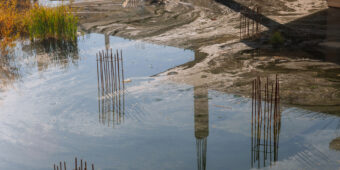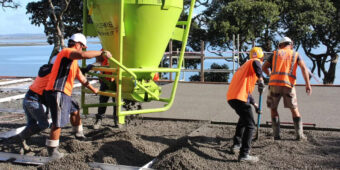Summer safety – seasonal hazards
24 Feb 2015, Featured, Prove Your Know How, Safety

Summer doesn’t just run from December to February, it often starts in February and can end after April! This year has been unusually dry so far, which brings an increased risk of dehydration and dust exposure on construction sites
The perks of summer include long hours of daylight and truck loads of fine weather. Unfortunately, the summer and early autumn months typically have higher accident rates.
Why?
For starters, more construction work is undertaken, often over longer hours. In addition, the dry and hot conditions increase dust exposure and dehydration. A combination of these conditions can result in fatigue and create long-term health problems.
To keep yourself and others safe, you can start with reducing dust exposure. You should also make shade and hydration a priority on your work site.
Dust dangers
Breathing in dust can have both acute and chronic effects, potentially causing long term-health issues for builders.
Dust is generated by:
- Cutting, sanding, grinding, sweeping and polishing.
- Old lead pipes (lead oxide dust).
- Stripping out fibrous insulation, lagging or packing materials (potentially asbestos).
- A dry and exposed work site.
- Wind and heat.
In dry weather, the circulation of dust in the air increases. Eliminating all traces of dust during a job is near impossible, but you can reduce its presence and impact.
Take sand, for example. It can be fatal when breathed into your lungs over time and, if it’s one of your key building materials, on a windy day your product is literally flying away.
Long-term exposure to silica dust – a major component of beach sand and granite – can cause silicosis. Cutting fibre cement and ACCP also exposes people to silicosis.
Silicosis is a specific form of lung disease, caused by an accumulation of silica dust in the lungs.
Any level of silica exposure can result in silicosis. There are three types of silicosis: acute, accelerated, and chronic.
Acute silicosis forms a few weeks or months after high levels of silica exposure. This condition progresses rapidly.
Accelerated silicosis comes on five to ten years after exposure.
Chronic silicosis occurs ten years or longer after silica exposure. Even low exposure levels can cause chronic silicosis.
“Construction work involves a lot of high-risk activities; workers need to be physically and mentally alert
Silica dust particles act as tiny blades on the lungs. When silica is inhaled through the nose or mouth, particles create small cuts that can scar the lung tissue. Scarred lungs do not open and close as well, making breathing difficult.
Testing for it is difficult, so prevention for yourself and others is important. Symptoms to watch out for include:
- Frequent dry coughing.
- Shortness of breath.
- Wheezing.
- Increased tiredness.
How to reduce the health risks associated with dust
Keep yourself and others safe by preventing exposure to dust where possible, or at least control it.
- Reduce and eliminate dust by:
- Spraying surfaces with water.
- Covering piles of sand or gravel outdoors.
- Extracting (using tools with extraction systems or ventilation machines).
- Cleaning regularly; when cleaning and sweeping the site, you can reduce air-borne dust with water and/or using a vacuum.
Use personal protective equipment, such as:
- Respiration equipment with instructions for correct use (either reusable or disposable).
- Eyewear to protect you from harmful airborne particles.
Stay hydrated!
Water makes up 62% of our bodies. It’s really important to stay hydrated for a successful day’s hard work.
Construction work involves a lot of high-risk activities; workers need to be physically and mentally alert. When you’re working and sweating, it’s more important than ever to make sure you stay hydrated.
Dehydration causes fatigue, headaches and short tempers, which can cause:
- Accidents.
- Resource and cash wastage.
- Equipment damage.
- Decreased productivity.
To keep everyone working at peak performance, we recommend:
- Regular breaks with readily available water.
- Covering the working area, if possible – this could be achieved with shade cloth.
- Doing heavier work during cooler periods, if possible.
- Covered areas can heat up – have a few fans set up to circulate some fresh air.
- Keeping an eye on yourself and the people around you – if feeling dizzy or fatigued, take a break from the sun and have a drink of water.
Whatever your project, making sure it is safe during these hot months is essential to your success.
To keep things moving smoothly on your work site, and to improve the health of yourself, your workers and your bottom line, you should eliminate/control dust as much as you can, keep everyone hydrated and ensure work areas are well ventilated.
More Information
Contact your local Site Safe Advisor for help in developing and applying your own heat and dust policies and procedures – www.sitesafe.org.nz/advisors
Site Safe is a national not-for-profit membership organisation that promotes, supports and inspires a culture of health and safety in the NZ construction industry.
Register to earn LBP Points Sign in



